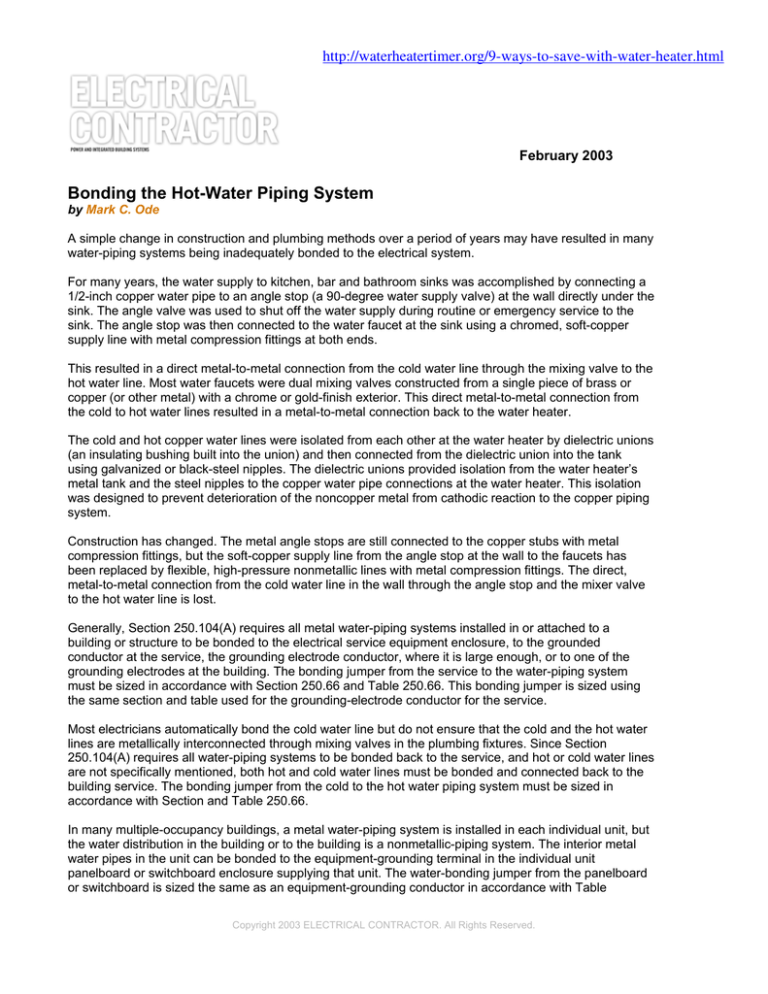Bonding the Hot-Water Piping System February 2003
advertisement

http://waterheatertimer.org/9-ways-to-save-with-water-heater.html February 2003 Bonding the Hot-Water Piping System by Mark C. Ode A simple change in construction and plumbing methods over a period of years may have resulted in many water-piping systems being inadequately bonded to the electrical system. For many years, the water supply to kitchen, bar and bathroom sinks was accomplished by connecting a 1/2-inch copper water pipe to an angle stop (a 90-degree water supply valve) at the wall directly under the sink. The angle valve was used to shut off the water supply during routine or emergency service to the sink. The angle stop was then connected to the water faucet at the sink using a chromed, soft-copper supply line with metal compression fittings at both ends. This resulted in a direct metal-to-metal connection from the cold water line through the mixing valve to the hot water line. Most water faucets were dual mixing valves constructed from a single piece of brass or copper (or other metal) with a chrome or gold-finish exterior. This direct metal-to-metal connection from the cold to hot water lines resulted in a metal-to-metal connection back to the water heater. The cold and hot copper water lines were isolated from each other at the water heater by dielectric unions (an insulating bushing built into the union) and then connected from the dielectric union into the tank using galvanized or black-steel nipples. The dielectric unions provided isolation from the water heater’s metal tank and the steel nipples to the copper water pipe connections at the water heater. This isolation was designed to prevent deterioration of the noncopper metal from cathodic reaction to the copper piping system. Construction has changed. The metal angle stops are still connected to the copper stubs with metal compression fittings, but the soft-copper supply line from the angle stop at the wall to the faucets has been replaced by flexible, high-pressure nonmetallic lines with metal compression fittings. The direct, metal-to-metal connection from the cold water line in the wall through the angle stop and the mixer valve to the hot water line is lost. Generally, Section 250.104(A) requires all metal water-piping systems installed in or attached to a building or structure to be bonded to the electrical service equipment enclosure, to the grounded conductor at the service, the grounding electrode conductor, where it is large enough, or to one of the grounding electrodes at the building. The bonding jumper from the service to the water-piping system must be sized in accordance with Section 250.66 and Table 250.66. This bonding jumper is sized using the same section and table used for the grounding-electrode conductor for the service. Most electricians automatically bond the cold water line but do not ensure that the cold and the hot water lines are metallically interconnected through mixing valves in the plumbing fixtures. Since Section 250.104(A) requires all water-piping systems to be bonded back to the service, and hot or cold water lines are not specifically mentioned, both hot and cold water lines must be bonded and connected back to the building service. The bonding jumper from the cold to the hot water piping system must be sized in accordance with Section and Table 250.66. In many multiple-occupancy buildings, a metal water-piping system is installed in each individual unit, but the water distribution in the building or to the building is a nonmetallic-piping system. The interior metal water pipes in the unit can be bonded to the equipment-grounding terminal in the individual unit panelboard or switchboard enclosure supplying that unit. The water-bonding jumper from the panelboard or switchboard is sized the same as an equipment-grounding conductor in accordance with Table Copyright 2003 ELECTRICAL CONTRACTOR. All Rights Reserved. 250.122. If there is no direct metal-to-metal connection between the hot and cold water pipes, the bonding jumper from the cold to the hot water line must still be installed, but the bonding jumper would be sized in accordance with Section 250.122. Where a separately derived system is installed, the grounded conductor of the separately derived system must be bonded to the nearest available point of the interior metal water-piping system in the area served by each separately derived system. The bonding jumper connection must be made at the same point on the separately derived system where the grounding-electrode conductor is connected. Each bonding jumper must be sized in accordance with Table 250.66. Again both the hot and the cold water pipe must be bonded to the separately derived system. Next time you install an electrical system, be sure to check both the hot and cold water lines to ensure proper bonding of the water piping system to the service. About This Author Mark C. Ode ODE is staff engineering associate at Underwriters Laboratories Inc., in Research Triangle Park, N.C. Phone: 919-549-1726 Email: mark.c.ode@us.ul.com Copyright 2003 ELECTRICAL CONTRACTOR. All Rights Reserved.




